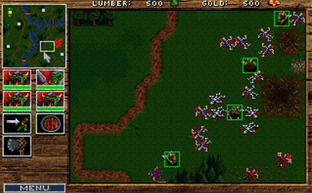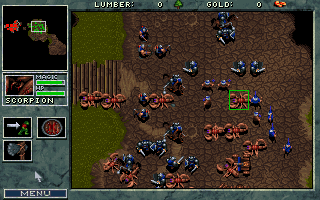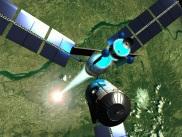-=- Full "Retro Mortis" Series Article Index -=-
Retro Mortis - RTS (Part 1) - It was found in a Desert...
Retro Mortis - RTS (Part 2) - Then a Blizzard came...
Retro Mortis - RTS (Part 3) - Forged in Steel...
Retro Mortis - RTS (Part 4) - A New Hope?
Greetings,
While not mandatory, it would be advisable to have read
the first part of this article before proceeding.
Context
During my last article, I've entertained that Dune II was the original precursor of the RTS genre, and have argued that it had led to a "conflict" that opposed Westwood Studios (Now defunct, formerly under EA leadership) and Blizzard Entertainment (now part of Activision Blizzard) from 1992 to 1998.
The fierce competition during these years helped shape what would become of the modern RTS. I thought it only fitting to take a look at Blizzard's response to Westood and see where things went from there.
Please note that without Patrick Wyatt's invaluable recollection, this article would not have been made possible.
Warcraft: Orcs and Humans

Warcraft was a great game that received positive reviews and generated a lot of traction back in the days. When broken down to its essence however, it differs slightly from Dune II. It shines by its ability to condense and simplify the genre, through execution, not feature-creep. In many ways, what makes it great is also a big part of the reason why RTS became
streamlined (for better
and for worse)
Multiplayer
Warcraft's primary innovation is the concept of multi-player. In Blizzard's original vision of the RTS, it was a game that was meant to be played competitively. Limited by the technology of its time, it still managed to boast a modem-bound multiplayer system. It even allowed crossover multiplayer on different platforms (PC vs MAC).
Since this was the first foray into the RTS multiplayer experience, it was provided "as is" with limited support. There were no specific gameplay features attached (ladders would only come with future installments).
To make room for its multiplayer, Blizzard also helped define the core differences between the Single and Multi player experiences.
Single Player...
...has an engaging storyline (much more characterization and context than Dune II).
...has a variety of threats and encounters (mirror matches (human vs human), npcs (scorpions, ogres), etc.)
...has a variety of objectives (rebuild a town, survive for a given duration, limited forces (no base), etc.)
Multi Player...
...is a head-to-head match-up where both forces
have an equal chance of winning.
...places the burden of "fun" on how players seek to defeat one another and assumes balanced opponents are facing off.
 A heated multiplayer match...
A heated multiplayer match...
Obviously, multi-player would still need to come a long way before it became anywhere close to balanced. Multi-player match-ups in Warcraft: Orcs and Humans were generally one-sided where the player that better understood the game mechanics would quickly come on top. There were no "league" systems or any regulation of any kind.
Though Warcraft: Orcs and Humans was possibly the first serious foray in multiplayer RTS games, this game mode would be honed by future installments, especially Warcraft II: Tides of Darkness, Starcraft and Starcraft II: Wings of Liberty. (
Warcraft III being left out intentionally)
Economy
Resources changed a lot with Warcraft. From mere "spice laying on the ground" they've evolved into two distinct sources: Trees (Forest) and Gold (Mine). Yet, the biggest change in the economy is the introduction of the complex economic units: Peasants (Peons).
Peasants are "complex" because they provide the player with meaningful decision-making (and cost of option). They're both able to build structures (using resources) and harvest resources (acquiring resources). They affect the resource flow positively AND negatively. Choosing to order a peasant to build a structure has several implications:
- It removes the peasant from the task it was performing: this is a cost of option as the player is accepting that the ongoing labor will no longer result in resources being acquired. Since the unit is immobilized for a certain duration, the effect can be quite dire.
- It consumes resources based on the structure cost. This is another cost of option as these resources cannot be used elsewhere from here on.
- It provides the player with a new structure (when construction is completed). Depending on what that structure is, it can help the player economically or militarily, but generally will require further investments. The building generally provides further cost of option (building a footman? at what cost?).
The complexity of these units, and their relatively inefficient collection rate (compared to Dune 2) insured that players' armies would now have a significant portion of "civilians" (peasants/peons), which in turn introduced a higher level of vulnerability but also some redundancy.
Unlike Dune II, where the base economic unit was armored, and focused, peasants are extremely frail and can be everywhere (and often need to be scattered). The loss of a peasant, though not as threatening as an harvester, was much more common. While the Dune II harvester could be escorted by big guns, the peasants cannot be escorted individually, instead, peasants need to be thought of as "supply lines" which we'll discuss below.
The concept of complex economic units was upheld and refined through various Blizzard games but also many others going so far as to put a lot more emphasis on these units in games like Supreme Commander.
***
In Warcraft: Orcs and Humans, resources are a physical entity which adds tactical depth. For example, trees also act as collisions which means that players need to be particularly careful about where they get their wood. Opening their flank in the early game before proper forces are made can lead to unwanted encounters.
Wood thus acts as a natural protection barrier which thins out as one's base grows, but it still requires proper management to avoid a few obvious pitfalls.
Likewise, proper harvesting of wood around an enemy base may reveal a particularly "weak spot" to invade from, so it is not uncommon to employ peasants to cut lumbers nearby the enemy base to provide more opportunities.
Mines, on the other hand, are extremely focused. They represent a narrow object on the map that needs to be controlled at all costs. Securing a distant mine becomes a critical objective as the mines are finite in nature: whatever gold your opponent gets you won't be able to get.
Furthermore, mines require peasants to harvest and return home without any "proxy" base to gather from. This results in rather long supply lines that need to be defended from enemy incursions. As a general rule of thumb, the further the mine, the harder it is to defend that supply train, and the more casualties the player will register.
 That's what happens when you fail to defend your supply lines...
That's what happens when you fail to defend your supply lines...
Several series have made good use of complex resources. For example, the Age of Empire series retained the "trees" aspect as most resources occupy physical space. The gold mine system was also refined in various ways, namely by Starcraft which added the concept that a focused resource should require a dedicated investment (refineries need to be built upon Vespene Geysers in order to be controlled).
Logistics: Roads
An often forgotten mechanic from Warcraft: Orcs and Humans that was not present in either sequels was the inclusion of "roads". These were mandatory to construct buildings and expand the base. In a way, they played the same role as energy, minus its vulnerability. One would have to pay good money to have roads established. This emphasized the need to keep a closed base (use as few roads a possible given the cost).
In a way, roads are the children of the concrete slab in Dune II. The slabs were initially established to insure buildings would be sturdy, but ultimately, it was a means to build proxy bases cheaply (without the use of a MCV).
Unfortunately, the roads pale in comparison to the slabs, and did not add much in terms of gameplay. What it did however is provide a sense of community and strong lore: the players are building
encampments, not just buildings here and there. Though the implementation was relatively poor, it was found to be lacking in later installments.
 Roads, building communities since 1994!
Roads, building communities since 1994!
A number of RTS games with a bit more focus on city building have used the roads to great effect afterwards by merely assessing the UX aspect. Having the ability to drag in order to build more than one road every 3 clicks turned out to greatly diminish the negative frustrations associated with road building, and adding a speed boost on units that walked over roads gave it a gameplay purpose.
It is unclear why this was truly added to Warcraft: Orcs and Humans (perhaps playtesting revealed the dangers of "proxy barracks"?) but though its implementation suffered, it remains one of the most under-utilized mechanic in common RTS. Most games that have employed them had a direct link with Roman lore (roads were critical to their multiple campaigns) and I remain perplexed that logistics are not playing a more important role in modern RTS. That being said, its original potential was probably overshadowed by poor UX implementation and lack of tangible purpose: the roads were, essentially, a pain to build, and did not provide much advantage beyond cosmetics.
Food
While Dune II sported a flamboyant limit on building construction, Warcraft: Orcs and Humans decided to put emphasis on units. Dune II had a loose text message to determine that the max unit count for the entire game had been reached which basically pooled all in-game units into a zero-sum game: you would have to kill units if you were to build more of them.
This archaic form of handling unit capacity in games was around for a fair bit of time. For example, the turn-based strategy VGA Planets originally had the same approach: there is a maximum of 500 units in the game, no matter what. There comes a point where the max is reached, and the game handles it in a different way (in VGA Planets, it uses a system of points, which is mostly influenced by the amount of units you destroy, to determine who gets to build units when a "slot" frees up). Dune II was simplistic: whenever a unit would get destroyed, any unit currently "ready to deploy" could fill that slot, but the algorithm that determined which was arbitrary.
Warcraft fixed this design issue by implementing a "by faction" cap. Assuming the maximum amount of units any game could have was, say, 100, this was split across both factions (50 for orcs, 50 for humans). In Warcraft: Orcs and Humans, each "farm" building provides a few units of food (4 if I remember correctly) which means you can create 4 units for each farm. Likewise, your army can never be larger than 4 times the amount of farms you have, or larger than your ultimate faction capacity (half of the game's units). You can, technically, construct more farms than your actual cap, but they will only serve as redundancy in case other farms get destroyed.
What Warcraft recognized is a flaw in Dune II's (and many other games of its time) design: because base construction was limited, but not unit construction, it could lead to very aggressive build-ups. Since Warcraft insisted on competitive play, they couldn't allow it, and farms were a means to favor the defender: Assuming both factions always have the same amount of farms, the faction with the fastest reinforcements will be the one closest to the fight, de facto: the defender. This ensured that no amount of early aggressiveness could fully annihilate an opponent in the early game (unlike the "4pool" in Starcraft for example).
Also, since all units consumed exactly one "food", players were encouraged to build their tech tree and get the "best units" to fill these slots as quickly as possible. Having a fully capped army of footmen was not desirable when facing off against several raiders (orc knights).
The food system, however, left base growth rampant. Though limited by the construction of roads, a base could freely expand limitlessly.
Food was also very abstract when compared to energy. It was "just a number" and a very static resource. It worked well in its own right, but did not provide much depth.
In many ways, food was not necessarily the best solution, but it was certainly the simplest. It allowed to handle several of the design flaws of the original Dune which simply had no means to handle unit capacity properly, and prevented early rush tactics from being too efficient.
A quick aside here on the feature that "almost was" (as was recently revealed through Patrick Wyatt's blog): farms were originally meant to be part of a drastically more complex approach to unit development which would've resulted in peasants being "spawned" from farms over time, and then trained at the barracks into military units or used as is as economic units. In what he calls a "design coup", the concept was drastically simplified into this abstract concept. One can't help but wonder what might have happened should the original system had been implemented.
This barebone "Food System" has been used extensively by the Warcraft and Starcraft franchises, but also in other games such as the Warhammer series. It represents a very abstract means to achieve growth limitation and regulate army sizes. Though somewhat mainstream nowadays, it is important to note that it was found accidentally as a means to simplify an existing design that was deemed too complex at the time. It feels it has become the defacto common denominator of the RTS genre, though that may be a questionable status.
Asymmetry
Warcraft: Orcs and Humans' assymetrical design is much more smoke and mirrors than gameplay. All orc units look drastically different than their human counterparts, but they serve mechanically the same roles. Though some units vary slightly (archers have a slightly longer range but lower damage output than spearmen, and magic units have a slightly varying range) they are fundamentally the same.
 With Blizzard, there's no cheap color swaps...
With Blizzard, there's no cheap color swaps...
The only real mechanical differences comes in the form of spells, and despite this, most are actually the same (they only look different). For example:
- Both sides have a spell that allows them to reveal portions of the map (Dark Vision vs Far Fight)
- Both sides have a minor summon spells which summons creatures that are fairly similar (the spiders' damage is a bit more random)
- Both of them have a spell that can deal damage to a 1X1 area (over time dmg of 10) (Poison Cloud vs Rain of Fire)
- Both of them have a major summon spell which summons a powerful mob (The Demon is strong in melee and random, whereas the Water Elemental is ranged and has flat dmg)
 Spawning scorpions
Spawning scorpions
The only spells that trully differ are these:
- The Orcs can raise the dead (temporarily) to add a few skeletons to their army and increase their damage output when there are fresh corpses nearby
- The Orcs can sacrifice half the life of a unit to make them temporarily invincible (tanks).
- The Humans can use "healing" which is particularly helpful economically as it allows to maximize the use of "surviving units" and give an extra boost to forwards in the fray.
- The Humans can use "invisibility" which allows them to hide units so long as they don't attack and allow them deep into enemy lines.
All things considered, orcs and humans play much more alike than the different factions in Dune II, but because they are aesthetically different, it is easy to fall prey to this ruse and choose sides. What Blizzard brought forth with this installment is that it was equally important to support faction identity with pieces of lore and cosmetic overhaul. This is a thought they would build upon when designing their highly-acclaimed Starcraft a few years later.
Unit Upgrades
Dune II had a system for upgrades which allowed players to unlock further units in the tech tree, but it never really capitalized on this system. Warcraft: Orcs and Humans built upon it by adding upgrades that would affect units directly. They went so far as to having buildings that would only be used to improve units as a whole (loosely based on the House of IX building in Dune II).
From upgrades that would improve units' defenses and attacks up to outright new spells unlocked for spellcasters, these upgrades could easily lead to victory and defeat when misunderstood.
They added an economic layer to the game where knowing when to make units more powerful vs creating a new unit was necessary. Because an upgrade's value could be measured by the amount of units it would be applied to, it was possible to min/max this strategy when weighting the upgrade's cost, and a number of players started to understand that it was fertile grounds for very advanced strategies.
Random Map Generator
Borrowing from the Civilization series, the "Skirmish" mode had a random map generator which could potentially result in unlimited replayability.
As time would prove however, the value of this random map generator was limited in that it did not necessarily generate "fair and balanced" scenarios. Later installments would use "ladder maps" instead which had undergone serious level design efforts.
UX
Patrick Wyatt himself, lead programmer and producer of the game, would say that the feature he's ever been the most proud of was the multi-unit selection created for Warcraft: Orcs and Humans. He could very well be coined with the invention of that feature altogether, which no RTS has shunned ever since. Dune II was simply cumbersome to control, and it called for grouping. Though initially the feature was developed without limitations, some design constraints eventually led to multi-selection affecting only 4 units, thus making the feature much less useful, but nonetheless stellar. Suffice to say this one achievement was to become a staple of the genre.
 Multi-selection at work.
Multi-selection at work.
Yet he also created the control groups (using control + numbered key) which would also become yet another staple, allowing players to command specific groups of units to improve the player's grip on the game.
As Patrick puts it, the player's attention is the rarest resource in a RTS, and these additions came a long way to minimize the burden put on their shoulders and allowed them to better interface with the game. One could argue that, aside from multiplayer, Warcraft: Orcs and Humans' greatest legacy was its sheer focus on User Experience, which given the case, was no small feat.
Streamlining
Warcraft: Orcs and Humans started a process that several other RTS would refine which I like to call "streamlining".
The good about streamlining is that it makes things easier to use and understand, it lowers the barrier to entry and minimizes the amount of fore-knowledge one has to have in order to learn and play the game. In most cases, this is desirable as it effectively allows to do more with less.
The con with streamlining is that it sometimes eliminate depth. This often occurs when features were not implemented properly. With new installments, designers look at what worked and what didn't work and they axe features that didn't work without stopping at "why" they did not work. While this undeniably improves the quality of each subsequent installment it can also kill under-developed ideas that might have truly improved the game significantly.
- *Warcraft: Orcs and Humans removed the concept of mercenary units which was present in Dune II's starport (and would later be re-discovered by Ground Control).
- *It removed the sandworm.
- It removed energy (though that's one system Westwood would not let rot).
- *It gave up on a lot of the subtleties of landscaping.
- *It simplified (and almost removed) faction assymetry.
- *It greatly simplified the campaign map.
- It made the minimap visible de-facto (without the need of a specific building).
- It reduced the amount of units per faction from 13 to 7-8.
- It reduced the amount of buildings from 18 to 8.
Many of these decisions were for the best as it reduced unecessary complexity and resulted in a better management of "depth", but a few inevitably resulted in the loss of mechanics that could've been expanded instead. (I've put an asterisk next to the ones I humbly believe would've been worth revisiting). Some of these, such as the need for more assymetry, resurfaced years later with resouding success (Starcraft, for example).
Assessment
I postulate that Warcraft: Orcs and Humans was instrumental to the evolution of the RTS genre. Its legacy is twofold:
- On the one hand, it brought the RTS genre to the then rising multiplayer scene, forever associating RTS with PvP competition, and implementing the user interface tools to support that experience (multi-selection, control groups).
- On the other hand, it streamlined the original RTS design, focusing on very specific elements of the core gameplay to lower the barrier of entry to the genre, democratizing its use. However, it may have inadvertantly crystallized the core gameplay mechanics for titles to come along the way (sometimes relegating fresh ideas to the oubliette as a result)
Warcraft: Orcs and Humans is not an exercise of originality, it's an example of execution. Given the risk associated with making this game PvP, the developers chose to stick with simpler designs to create a new dimension: competitive gameplay.
In many ways, this streamlined experience is also largely responsible for establishing the RTS as a genre. Had the game explored many new features, people might have missed how "alike" the core mechanics were and never made any subsequent installments, but Warcraft: Orcs and Humans insured that Westood, Blizzard (and others) would duke it out to figure out who could come up with the best game in this vein.
 Warcraft was a great game that received positive reviews and generated a lot of traction back in the days. When broken down to its essence however, it differs slightly from Dune II. It shines by its ability to condense and simplify the genre, through execution, not feature-creep. In many ways, what makes it great is also a big part of the reason why RTS became streamlined (for better and for worse)
Warcraft was a great game that received positive reviews and generated a lot of traction back in the days. When broken down to its essence however, it differs slightly from Dune II. It shines by its ability to condense and simplify the genre, through execution, not feature-creep. In many ways, what makes it great is also a big part of the reason why RTS became streamlined (for better and for worse)
 A heated multiplayer match...
Obviously, multi-player would still need to come a long way before it became anywhere close to balanced. Multi-player match-ups in Warcraft: Orcs and Humans were generally one-sided where the player that better understood the game mechanics would quickly come on top. There were no "league" systems or any regulation of any kind.
Though Warcraft: Orcs and Humans was possibly the first serious foray in multiplayer RTS games, this game mode would be honed by future installments, especially Warcraft II: Tides of Darkness, Starcraft and Starcraft II: Wings of Liberty. (Warcraft III being left out intentionally)
A heated multiplayer match...
Obviously, multi-player would still need to come a long way before it became anywhere close to balanced. Multi-player match-ups in Warcraft: Orcs and Humans were generally one-sided where the player that better understood the game mechanics would quickly come on top. There were no "league" systems or any regulation of any kind.
Though Warcraft: Orcs and Humans was possibly the first serious foray in multiplayer RTS games, this game mode would be honed by future installments, especially Warcraft II: Tides of Darkness, Starcraft and Starcraft II: Wings of Liberty. (Warcraft III being left out intentionally)
 That's what happens when you fail to defend your supply lines...
Several series have made good use of complex resources. For example, the Age of Empire series retained the "trees" aspect as most resources occupy physical space. The gold mine system was also refined in various ways, namely by Starcraft which added the concept that a focused resource should require a dedicated investment (refineries need to be built upon Vespene Geysers in order to be controlled).
That's what happens when you fail to defend your supply lines...
Several series have made good use of complex resources. For example, the Age of Empire series retained the "trees" aspect as most resources occupy physical space. The gold mine system was also refined in various ways, namely by Starcraft which added the concept that a focused resource should require a dedicated investment (refineries need to be built upon Vespene Geysers in order to be controlled).
 Roads, building communities since 1994!
A number of RTS games with a bit more focus on city building have used the roads to great effect afterwards by merely assessing the UX aspect. Having the ability to drag in order to build more than one road every 3 clicks turned out to greatly diminish the negative frustrations associated with road building, and adding a speed boost on units that walked over roads gave it a gameplay purpose.
It is unclear why this was truly added to Warcraft: Orcs and Humans (perhaps playtesting revealed the dangers of "proxy barracks"?) but though its implementation suffered, it remains one of the most under-utilized mechanic in common RTS. Most games that have employed them had a direct link with Roman lore (roads were critical to their multiple campaigns) and I remain perplexed that logistics are not playing a more important role in modern RTS. That being said, its original potential was probably overshadowed by poor UX implementation and lack of tangible purpose: the roads were, essentially, a pain to build, and did not provide much advantage beyond cosmetics.
Roads, building communities since 1994!
A number of RTS games with a bit more focus on city building have used the roads to great effect afterwards by merely assessing the UX aspect. Having the ability to drag in order to build more than one road every 3 clicks turned out to greatly diminish the negative frustrations associated with road building, and adding a speed boost on units that walked over roads gave it a gameplay purpose.
It is unclear why this was truly added to Warcraft: Orcs and Humans (perhaps playtesting revealed the dangers of "proxy barracks"?) but though its implementation suffered, it remains one of the most under-utilized mechanic in common RTS. Most games that have employed them had a direct link with Roman lore (roads were critical to their multiple campaigns) and I remain perplexed that logistics are not playing a more important role in modern RTS. That being said, its original potential was probably overshadowed by poor UX implementation and lack of tangible purpose: the roads were, essentially, a pain to build, and did not provide much advantage beyond cosmetics.
 With Blizzard, there's no cheap color swaps...
The only real mechanical differences comes in the form of spells, and despite this, most are actually the same (they only look different). For example:
With Blizzard, there's no cheap color swaps...
The only real mechanical differences comes in the form of spells, and despite this, most are actually the same (they only look different). For example:
 Spawning scorpions
The only spells that trully differ are these:
Spawning scorpions
The only spells that trully differ are these:
 Multi-selection at work.
Yet he also created the control groups (using control + numbered key) which would also become yet another staple, allowing players to command specific groups of units to improve the player's grip on the game.
As Patrick puts it, the player's attention is the rarest resource in a RTS, and these additions came a long way to minimize the burden put on their shoulders and allowed them to better interface with the game. One could argue that, aside from multiplayer, Warcraft: Orcs and Humans' greatest legacy was its sheer focus on User Experience, which given the case, was no small feat.
Multi-selection at work.
Yet he also created the control groups (using control + numbered key) which would also become yet another staple, allowing players to command specific groups of units to improve the player's grip on the game.
As Patrick puts it, the player's attention is the rarest resource in a RTS, and these additions came a long way to minimize the burden put on their shoulders and allowed them to better interface with the game. One could argue that, aside from multiplayer, Warcraft: Orcs and Humans' greatest legacy was its sheer focus on User Experience, which given the case, was no small feat.











It wasn't worth withholding the article for this, but do note that your Assessment is repetitive